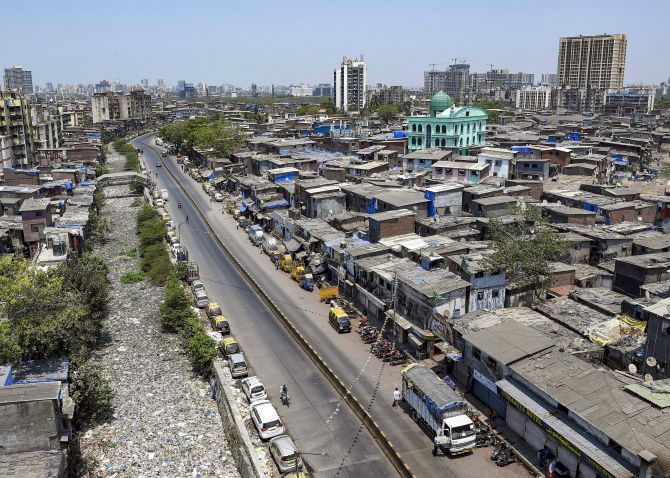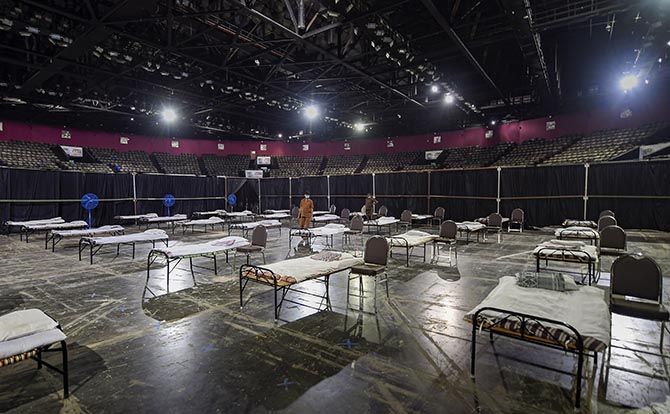 | « Back to article | Print this article |
'Considering Mumbai's population density, one can expect to see more positive cases in areas like Dharavi in the days to come.'
'That is the challenge before the public health infrastructure and preparation of the city in dealing with such crises.'
Prasanna D Zore/Rediff.com reports.

With as many as 22 people testing positive for COVID-19 in the Dharavi slums in Mumbai, the city's civic administration is likely to face its biggest health challenge in containing the spread of coronavirus with an epidemiologist expressing concern that the transmission in the city has already reached transmission stage.
The city has till now reported 64 confirmed deaths due to COVID-19 out of 993 COVID-19 positive cases (as of April 10).
Maharashtra has 1,574 cases and a death toll of 97 (as of April 10). Out of these, 218 fresh cases and 10 deaths were reported in the last 24 hours in Mumbai.
With such a sharp surge in the number of fatalities, the city has emerged as a COVID-19 hotspot. The state administration as well as BrihanMumbai Municipal Corporation-run hospitals in Mumbai, on their part, have ramped up screenings and testing capacity, quarantining people who show symptoms and enforcing a strict lockdown across 381 containment zones.
Has Mumbai reached the community transmission stage?
As health experts find ways to contain the spread of coronavirus, there is disagreement between them about the pace at which the virus is spreading in the city.
While BMC officials told the Hindustan Times that the city has reached community transmission stage, state government officials as well as doctors working in BMC-run civic hospitals strongly refute this claim.
"We have not reached the community transmission stage," Dr Archana Patil, director, health services, Maharashtra, tells Rediff.com over the phone.
"Community transmission happens when a person tests positive for COVID-19 without having any known international or domestic travel history and who has not come into contact with a COVID-19 positive patient but still tests positive," Dr Patil explains why the city cannot be categorised as having reached stage three or community transmission stage.
"Community transmission happens when the coronavirus spreads in a limited geographical location from a person who has tested positive for COVID-19 without satisfying the above two conditions," she elaborates.
A senior epidemiologist working at a BMC-run hospital reflects Dr Patil's assessment.
"The COVID-19 pandemic has not yet reached the community transmission stage despite the first two cases from Dharavi that are being categorised as spread due to 'community transmission'," says the epidemiologist on condition that his name should not be cited in this report as he is not authorised to comment on the issue.
"We have not reached the community transmission stage. We are somewhere a little ahead of stage II and far behind stage III transmission which is considered community transmission," he says.
"As an epidemiologist I can tell you that there has not been a very high surge in COVID-19 positive cases (in Mumbai). See, if we test more, the chances are we will get more positive cases and we have begun testing on a bigger scale now," he says, explaining why the number of cases are rising in the city.
Clarifying why the two people who first tested positive for coronavirus in Dharavi cannot be considered cases of community transmission, the epidemiologist says, "While they didn't have any travel history they may have come into contact with those who were positive."
"The people from whom these two Dharavi residents got their infections can be traced and must have been traced and quarantined," he adds. "This is not apparent because the BMC does not disclose these details."
Another epidemiologist, who is also at the frontline of containing the spread of coronavirus and works at another BMC hospital, says, "We reached the community transmission stage almost a week ago. We have had cases that have tested COVID-19 positive without having any travel history or any known contact with a COVID-19 positive patient," he says, referring to the same two cases from Dharavi.
The spread of coronavirus
But more than Dharavi, this epidemiologist pins the blame on the city reaching stage III on the lax arrangements provided to healthcare officials and airport staff at Mumbai's Chhatrapati Shivaji Maharaj International Airport in the days when alarm bells had just begun to get louder.
"The airport staff and doctors there did not have any protective masks when this all began sometime in mid-March. Some people from the airport have tested positive," he reveals.
"Some of these staff living along the periphery of the airport must have tested positive for COVID-19 and spread the infection to those who came in contact with them," he explains.
"It could also have spread from healthcare workers who are at the frontline. Suppose, I am a healthcare worker who has come home after being in the presence of a COVID-19 patient. The virus can stay alive on clothes for 12 hours. If I don't disinfect these clothes as per standard protocol and if anybody from my home comes into contact with these contaminated clothes, then there is high chance of the other person getting infected," he explains.
"The community spread could happen due to multi-causal factors," he adds, offering another probable reason why the spread in Mumbai could have reached stage III.
According to this doctor, community transmission spreads in cycle and continues like an uncontrolled chain reaction.
"Suppose if I am a COVID-19 positive person and if I come in contact with five people out of which three get infected and test COVID-19 positive. These three, who are infected, in turn pass it on to the three, each taking the figure to 9 who will then take it to 27 (it spreads exponentially) and so the chain reaction continues. This is how such infections go viral," he explains.
"The Dharavi cases did not have any history of travel; they must have got infected from someone in the community outside Dharavi with whom these two must have come in contact with," he adds.

The fightback
"That's the reason why lockdowns and containment zones are so crucial in stopping community transmissions," explains the senior epidemiologist quoted earlier.
Mumbai, which had 212 containment zones two days ago, has seen this number rise to 381 as the lockdown seems to be failing to contain the community transmission.
"We have now sealed almost 400 localities across the city as these areas have higher chances of spreading community transmission," says the second epidemiologist.
"Just so that this community transmission doesn't get viral, the BMC and state administration has taken the decision to create these containment zones where nobody is allowed to enter or exit from these localities. Again these localities have started mohalla clinics so that those showing symptoms could be isolated and sent for tests or home quarantined," adds the younger epidemiologist.
"That is what the lockdown is for. To stop the spread of coronavirus and prevent it from reaching Stage III, the BMC has created containment areas, which are a harsher version of a lockdown," says the senior epidemiologist.
"That is why even doctors are requesting the public to stay at home and prevent themselves and others from getting coronavirus infection. You move out and you get it at your own place and the source remains unknown. If that happens, then community transmission is very difficult to contain," he says.
According to him, all the doctors at BMC-run hospitals are following the standard operating protocols meticulously.
"That is the reason why you don't find even a single BMC doctor getting infected from coronavirus even though you have such cases happening abroad," he says. "We wear (N95) masks, PPEs (personal protection equipment), sanitise our hands mandatorily. We have a very meticulous plan of action at every health institute in Mumbai."
"We will need to continue with the sealing off of these containment areas for at least 20 more days if we were to stop community transmission. That's the only way out. The last two swabs of the last COVID-19 patient should test negative for us to break the chain of community transmission," says the second epidemiologist.
Offering an insight into the sudden surge of COVID-19 positive patients in Mumbai, the senior epidemiologist says, "Now that we have increased our testing capacity manifold, the graph of increase or decrease in COVID-19 positive patients can only tell how long it would take to completely contain the spread of coronavirus."
According to him, Maharashtra has built the capacity to test 18,000 people in a day at various state-run, district and block-level healthcare centres, with one-third, or 6,000, of these tests happening in Mumbai alone.
The dark clouds and silver lining
Like every dark cloud having a silver lining, the fact that the rate at which Indians are getting infected is far slower compared to global standards.
Another positive is the fact that many Indians have been vaccinated for BCG (Bacille Calmette Guerin) that offers effective immunisation against tuberculosis. According to research reports, this vaccine prevents coronavirus infections, and that could act as a major positive for the country, says the second epidemiologist.
"The one positive factor that works in India's favour is that compared to global standard, the percentage of COVID-19 positive patients (out of the total tests done) stand at just 4 to 6 per cent," he says.
"The other positive for us Indians is that most Indians have taken BCG vaccine, which as many research papers have shown, helps prevent coronavirus infection," he adds.
"The only concern is many old people above 60 to 70 may not have taken the BCG vaccine and also those living on the margins or in slums may not have taken the BCG vaccine. Those who have not gone for BCG vaccination are emerging as a high-risk category," he says about the dark clouds hovering over India's fight against COVID-19.
Another dark cloud for a city like Mumbai, where space is at premium and people live in cramped clusters like Dharavi will pose major challenge in the days ahead, he says.
"Considering Mumbai's population density, one can expect to see more positive cases in areas like Dharavi in the days to come. That is the challenge before the public health infrastructure and preparation of the city in dealing with such crises," he says.
"Almost 4 to 6 people stay in dingy tenements and even if one of them gets positive without knowing it, he is likely to go out and infect many others aiding the community transmission cycle," he adds.
"BMC doctors will really have to make huge efforts to stop and contain community transmission in Mumbai's slums."